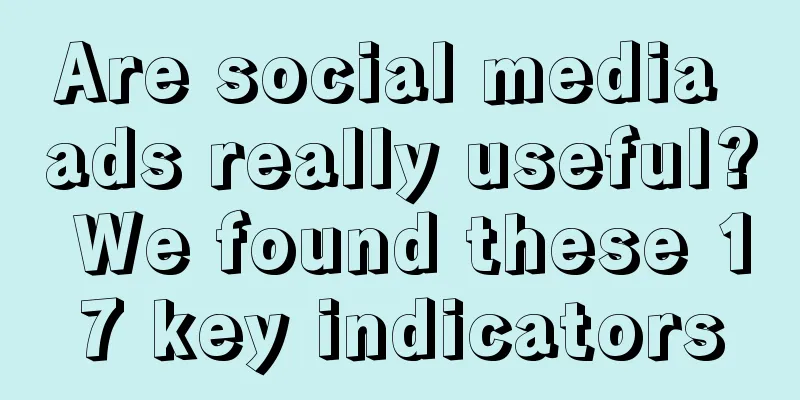Are social media ads really useful? We found these 17 key indicators

Social media plays a vital role in brand building and attracting consumers. According to the data of "Social Media Shopping" released by DISQO, more than 80% of consumers use social media every day, which fully demonstrates the high level of consumer participation on these platforms . Therefore, brands need to accurately adjust their advertising investment on various social platforms and channels to maximize advertising effects. So, how can brands achieve this goal? Knowing yourself and your enemy is the key to success. Brands need to gain a deep understanding of how their campaigns perform compared to their peers . Having reliable benchmark data is crucial in this process, as marketers can evaluate whether their social media strategies are achieving the desired results and make more targeted adjustments. In this report, DISQO compares cross-channel lift (Cross-channel benchmarks include OTT/CTV, digital display, mobile, streaming audio and social media) with social media lift (Social Media Lift) . The cross-channel benchmarks include OTT/CTV, digital display, mobile, streaming audio and social media; the social media benchmarks include Facebook, Instagram, Snapchat, TikTok, Twitter (ie. X), Pinterest and Reddit. 1. Research shows that social media advertising should take into account both brand and effectBefore the introduction, we need to understand the difference between Brand Lift and Outcomes Lift. Because they are a set of important indicators for "assessing the impact of advertising exposure on consumers", using these two together can provide us with a powerful and comprehensive evaluation of advertising effectiveness. Brand lift focuses on evaluating how advertising changes consumers’ attitudes and perceptions of a brand. It helps brands understand whether the advertising campaign successfully delivers the intended message to consumers and has a positive impact on brand perception. Results improvement focuses more on how advertising influences consumers' online behavior, which can help brands gain a deeper understanding of which consumer behaviors are driven by their advertising. The report shows the benchmark data (median) of 8 brand enhancement indicators (Figure 1, unprompted awareness, prompted awareness, brand familiarity, advertising recognition, slogan association, brand favorability, brand consideration, and purchase intention) and 9 outcome enhancement indicators (Figure 2, category search, category website visits, category e-commerce sales, competitor search, competitor website visits, competitor e-commerce sales, brand search, brand e-commerce visits, and brand e-commerce sales). Figure 1: Brand Lift Index | Source: DISQO Figure 2: Outcomes Lift Indicator | Source: DISQO The specific presentation method is to first list the " Median Lift Scores for a Typical Campaign Across Channels " corresponding to these 17 indicators, and then compare them with the "Median Lift Scores for Social Channels Only". In Figures 1 and 2, dark blue and dark purple represent the median across channels from March 2021 to December 2023 ; light blue and light purple represent the median for a single social media channel from March 2021 to December 2023. The social multiplier in parentheses is the lift from social media alone divided by the cross-channel lift. (Note: 1.0x means social media performs as well as all other channels combined, while a higher number means the social media channel performs “x” times better than other channels.) So, what important information can we draw from it and what key conclusions can we draw? Conclusion 1: Social media advertising achieves a 6.4-fold advertising awareness multiplier effect: precise positioning and interactive advantages stand out Social media advertising has a multiplier effect of up to 6.4 times in terms of ad awareness, which undoubtedly highlights its significant advantages in advertising promotion. Whether it is through precise targeting of the target audience, leveraging the interactive nature of social media platforms to enhance user engagement, or a perfect combination of the two, it has been fully demonstrated that social media advertising can efficiently convey information and maximize advertising value. Conclusion 2: Social media advertising leads multiple brand indicators, highlighting the effectiveness of advertising promotion Social media advertising has shown strong performance above cross-channel averages across several key brand metrics, including ad awareness, brand consideration, and purchase intent. Social media advertising has proven to be effective in increasing brand influence and driving consumer behavior. Not only that, social media advertising also outperforms cross-channel standards in brand search, brand site visitation and e-commerce. In summary, social media advertising has demonstrated clear advantages in driving behaviors in the upstream, midstream, and downstream of the marketing funnel, providing strong support for enhancing brand value and achieving consumer conversion . 2. What role does social media advertising play in the four common categories ?While social media advertising outperforms across channels overall, does this still hold true when we drill down further into specific categories? DISQO adds four categories , namely consumables , goods , services and vehicles , based on Figures 1 and 2. Each category also corresponds to 17 indicators. Different from Figures 1 and 2, the data corresponding to the four categories are social multipliers. The social multiplier here is equal to the single social media benchmark score for the category divided by the cross-channel benchmark score. So, what characteristics and trends does social media advertising show in these four specific categories? 1. ConsumablesSocial media advertising performs particularly well in improving key indicators such as consumable product awareness , favorability and purchase intent . However, for such products, specific performance indicators such as e- commerce purchases are not the main consideration. Consumable brands should focus more on driving the improvement of upper-level indicators of the brand and ensure that their purchase path is smooth and unobstructed. Through such a strategy, brands can establish a solid brand image, further enhance consumers' purchasing intention, and ultimately lead to a significant increase in sales. 2. ItemsSocial media advertising had a significant impact on product sales results, especially in increasing category site visits and e- commerce sales for the brand. However, it also drives Search and E-commerce for Competitors to some extent. On other sales outcome metrics, the impact of social media advertising was relatively modest. Since items tend to be higher priced and have a smooth path to purchase, they are more significantly impacted in terms of Search and Site Visits . 3. ServicesSocial media advertising is helpful in increasing the awareness of service products and shows better results in most performance indicators. Because service products often involve complex and long-term purchasing decisions, such as choosing an internet provider or subscribing to a streaming service, effective social media advertising can drive consumer discovery of services and comparison of competing products. However, consumers often need more detailed information than social media ads can provide before making a final purchasing decision. 4. AutomobileAutomotive ads are extremely effective at driving Category Site Visits . After all, cars are expensive and consumers often do in-depth comparison shopping. However, since automotive is a new category in the DISQO benchmark, the data is not yet complete and is insufficient to support a comprehensive analysis of all indicators. Through the above analysis, we can clearly see that social media advertising has shown strong influence and multiplier effect in different categories. Whether in the field of consumables, goods, services or automobiles, social media has provided strong support for brand building and consumer attraction with its unique precise positioning and high interactivity. As consumers become increasingly dependent on social media platforms, brands need to pay more attention to and make good use of this channel. By deeply studying the target audience, accurately formulating advertising strategies, and continuously optimizing advertising content, brands can fully utilize the advantages of social media advertising and maximize advertising effects. In the future, as social media technology continues to develop and innovate, we have reason to believe that its role in brand building and consumer attraction will become more prominent. Brands need to keep up with this trend and continuously innovate and optimize their social media advertising strategies to cope with increasingly fierce market competition. Author: DISQO Compiler: Jeff Source: WeChat public account: Morketing (ID: Morketing) |
Recommend
Show your face for five seconds and count money for two hours, 6 cases reveal how brands seize the summer season?
Co-branding is one of the most commonly used metho...
How to choose products for e-commerce
In the field of e-commerce, product selection is a...
Brands need to learn psychological compensation
This article uses compensation psychology as a sta...
Wufangzhai uses marketing to attract young people to follow the "traditional" trend!
Wufangzhai, a century-old Chinese time-honored bra...
People in big companies have side jobs, and the end is to leave the blogger?
In this era where everyone is a self-media, young ...
The number of fans increased by 6.7 million in 3 months, and an 80-year-old man took the center position on Douyin
The identity of "grandma" is a popular t...
Is DHgate worth working for? My experience after working at DHgate for a month
As a cross-border e-commerce platform, DHgate.com ...
With 47 million members and an online GMV exceeding RMB 5 billion, how does Rainbow Department Store achieve sustained growth through private domains?
Private domain operations are crucial to brand gro...
How to break through the conversion bottleneck of online education through operation, you must understand this method
Conversion rate is like a curse on every online ed...
Can I still ship if the Amazon IPI is less than 500? How to improve Amazon IPI?
Amazon ipi is very important data. Merchants need ...
Does Amazon have any requirements for sku? How to set it?
Amazon has strict regulations and requirements for...
Can Amazon reviews be deleted? Which negative reviews can be deleted?
After buying something on Amazon, you can leave a ...
iQIYI's "Matryoshka Membership" has robbed the precious VIP members
In 2022, the development of long videos is becomin...
Can I submit my registration information again if it fails? Reasons Analysis
If you want to open a store on Shopee, you need to...
Is eBay cross-border e-commerce legal? How much is the annual fee?
In the cross-border e-commerce industry, eBay, as ...




![[Special Topic on Overseas User Research] Top Ten Challenges Faced by Google User Researchers](/upload/images/67e6fa3ec4a61.webp)




